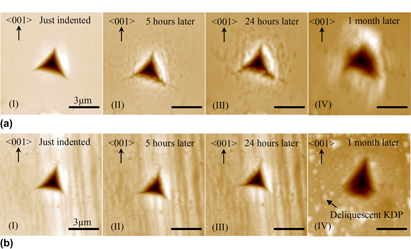Crossref Citations
This article has been cited by the following publications. This list is generated based on data provided by
Crossref.
Gao, Wei
Ji, Jianwei
Wang, Chao
Wang, Lili
Fan, Qichao
Sun, Kaihua
Ji, Fang
and
Xu, Min
2018.
Mitigation of subsurface damage in potassium dihydrogen phosphate (KDP) crystals with a novel abrasive-free jet process.
Optical Materials Express,
Vol. 8,
Issue. 9,
p.
2625.
Zhang, Yong
Hou, Ning
and
Zhang, Liang-Chi
2018.
Investigation into the room temperature creep-deformation of potassium dihydrogen phosphate crystals using nanoindentation.
Advances in Manufacturing,
Vol. 6,
Issue. 4,
p.
376.
Zhang, Yong
Hou, Ning
and
Zhang, Liang-Chi
2019.
Understanding the formation mechanism of subsurface damage in potassium dihydrogen phosphate crystals during ultra-precision fly cutting.
Advances in Manufacturing,
Vol. 7,
Issue. 3,
p.
270.
Hu, Yue
Zhu, Zhen
Xiao, Jiamin
Shao, Hezhu
Zhao, Li
Xu, Min
and
Zhuang, Jun
2019.
Atomic scale study of stress-induced misaligned subsurface layers in KDP crystals.
Scientific Reports,
Vol. 9,
Issue. 1,
Hou, Ning
Zhang, Liangchi
Zhang, Yong
and
Zhang, Feihu
2019.
On the Ultra-Precision Fabrication of Damage-Free Optical KDP Components: Mechanisms and Problems.
Critical Reviews in Solid State and Materials Sciences,
Vol. 44,
Issue. 4,
p.
283.
Hu, Y.
Zhu, Z.
Shao, H. Z.
Xiao, J. M.
Xu, M.
Zhao, L.
and
Zhuang, J.
2020.
Atomic dynamics of stress-induced lattice misalignment structures in a KDP subsurface.
RSC Advances,
Vol. 10,
Issue. 40,
p.
23944.
Zhang, Yong
Hou, Ning
and
Zhang, Liangchi
2020.
Effect of ultra-precision fly-cutting on the surface integrity of potassium dihydrogen phosphate crystals.
Optical Materials Express,
Vol. 10,
Issue. 4,
p.
971.
Grubiy, S. V.
Shavva, M. A.
and
Lapshin, V. V.
2020.
Proceedings of the 5th International Conference on Industrial Engineering (ICIE 2019).
p.
953.
Zhang, Yong
Hou, Ning
Zhang, Liang-Chi
and
Wang, Qi
2020.
Elastic-plastic-brittle transitions of potassium dihydrogen phosphate crystals: characterization by nanoindentation.
Advances in Manufacturing,
Vol. 8,
Issue. 4,
p.
447.
Chen, Mingjun
Ding, Wenyu
Cheng, Jian
Yang, Hao
and
Liu, Qi
2020.
Recent Advances in Laser-Induced Surface Damage of KH2PO4 Crystal.
Applied Sciences,
Vol. 10,
Issue. 19,
p.
6642.
Wenyu, Ding
Chen, Mingjun
Cheng, Jian
Yang, Hao
Zhao, Linjie
Liu, Qi
Liu, Zhichao
Gruzdev, Vitaly E.
Carr, Christopher W.
Ristau, Detlev
and
Menoni, Carmen S.
2021.
Surface damage evolution of KDP crystals induced by conical cracks under irradiation of nanosecond laser.
p.
81.
Mao, Jianhui
Liu, Wenjun
Li, Dongfang
Zhang, Chenkai
and
Ma, Yi
2021.
The Strain Rate Sensitivity and Creep Behavior for the Tripler Plane of Potassium Dihydrogen Phosphate Crystal by Nanoindentation.
Micromachines,
Vol. 12,
Issue. 4,
p.
369.
Hou, Ning
Zhang, Yong
Zhang, Liang-Chi
and
Wang, Ming-Hai
2021.
Material removal mechanisms and characteristics of potassium dihydrogen phosphate crystals under nanoscratching.
Advances in Manufacturing,
Vol. 9,
Issue. 4,
p.
558.
Yang, Shengyao
Zhang, Liangchi
Xie, Hongtao
and
Liu, Weidong
2021.
Interaction potential function for the deformation analysis of potassium dihydrogen phosphate using molecular dynamics simulation.
Computational Materials Science,
Vol. 187,
Issue. ,
p.
110122.
Rahaman, M.L.
and
Zhang, Liangchi
2021.
An investigation on the friction, wear and deformation of potassium dihydrogen phosphate.
Wear,
Vol. 476,
Issue. ,
p.
203624.
Yang, Shengyao
and
Zhang, Liangchi
2021.
Characterization of mechanical properties and failure of potassium dihydrogen phosphate under mechanical stressing.
Ceramics International,
Vol. 47,
Issue. 11,
p.
15875.
Yang, Shengyao
Zhang, Liangchi
and
Wu, Zhonghuai
2021.
Effect of Anisotropy of Potassium Dihydrogen Phosphate Crystals on Its Deformation Mechanisms Subjected to Nanoindentation.
ACS Applied Materials & Interfaces,
Vol. 13,
Issue. 34,
p.
41351.
Yang, Shengyao
Zhang, Liangchi
and
Wu, Zhonghuai
2022.
Effect of repeated nanoindentations on the deformation of potassium dihydrogen phosphate crystals.
Ceramics International,
Vol. 48,
Issue. 7,
p.
9595.
Yang, Ning
Yang, Xin
Huang, Wen
Zhao, Shun
and
Lei, Dajiang
2022.
Analysis of diamond tool wear mechanism in terms of stress for KDP Fly cutting.
Materials Today Communications,
Vol. 30,
Issue. ,
p.
103146.
Yang, Yun
Huang, Shuzhao
and
Pan, Shilie
2022.
K3Sr3Li2Al4B6O20F: a competitive nonlinear optical crystal for generation of a 266 nm laser.
Journal of Materials Chemistry C,
Vol. 10,
Issue. 31,
p.
11232.



